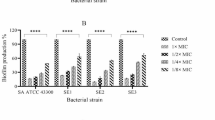Summary
The minimal inhibitory concentrations (MICs) and minimal fungicidal concentrations (MFCs) of amphotericin B, miconazole, ketoconazole, fluconazole, and itraconazole were determined for non-adhered cells and cells adhered to sections of a silicone urinary catheter. The densities of adhered cells were established with cells radiolabeled with tritiated leucine. Well defined MICs and MFCs were established for amphotericin B for representative adhered strains. In contrast, the azoles, especially fluconazole, did not give clear end points and the MICs and MFCs were arbitrarily determined. MFCs for the adhered cells generally were 2- to 5-fold higher than those of non-adhered cells. Techniques that include adhered-cell susceptibilities may be necessary before antifungal regimens for prosthetic device-associated yeast infections are appropriately defined.
Similar content being viewed by others
References
Ahearn, D.G. and J.B. Lawrence. 1984. Disseminated candidiasis caused by a sucrose-negative variant ofC. tropicalis. J. Clin. Microbiol. 20: 187–190.
Ahearn, D.G. and M.S. McGhlon. 1984. In vitro susceptibilities of sucrose-negativeC. tropicalis, C. lusitaniae, andC. norvegensis to amphotericin B, 5-fluorocytosine, miconazole and ketoconazole. J. Clin. Microbiol. 19: 412–416.
Anwar, H., M.K. Dasgupta and W. Costerton. 1990. Testing the susceptibility of bacteria in biofilms to antimicrobial agents. Antimicrob. Agents Chemother. 34: 2043–2046.
Armstrong, D. 1989. Problems in management of opportunistic fungal infections. Rev. Infect. Dis. 11: 51591–51599.
Branchini, M.L., M.A. Pfaller, J. Rhine-Chalberg, T. Frempong and H.D. Isenberg. 1994. Genotypic variation and slime production among blood and catheter isolates ofCandida parapsilosis. J. Clin. Microbiol. 32: 452–456.
Calhoun, D.L. and J.N. Galgiani. 1984. Analysis of pH and buffer effects on flucytosine activity in broth dilution susceptibility testing ofCandida albicans in two synthetic media. Antimicrob. Agents Chemother. 26: 364–367.
Calhoun, D.L., G.D. Roberts, J.N. Galgiani, J.E. Bennett, D.S. Feingold, J. Jorgensen, G.S. Kobayashi and S. Shadomy. 1986. Results of a survey of antifungal susceptibility tests in United States and interlaboratory comparison of broth dilution testing of flucytosine and amphotericin B. J. Clin. Microbiol. 23: 298–301.
Christensen, G.D., W.A. Simpson, A.L. Bisno and E.H. Beachey. 1982. Adherence of slime producing strains ofStaphyloccocus epidermidis to smooth surfaces. Infect. Immun. 37: 318–326.
Critchley, I.A. and L.J. Doughlas. 1985. Differences in adhesion of pathogenicCandida species to epithelial and inert surfaces. FEMS Microbiol. Lett. 28: 199–203.
Giwereman, B., E.T. Jensen, N. Hoiby, A. Kharazmi and J.W. Costerton. 1991. Induction of β-lactamase production inPseudomonas aeruginosa biofilm. Antimicrob. Agents Chemother. 35: 1008–1010.
Gristina, A.G. 1987. Biomaterial centered infection: microbial adhesion versus tissue integration. Science 237: 1588–1595.
Hawser, S.P. and L.J. Douglas. 1994. Biofilm formation byCandida species on the surface of catheter materials in vitro. Infect. Immun. 62: 915–921.
Hazen, K.C. and B.W. Hazen. 1992. Hydrophobic surface protein masking by the opportunistic fungal pathogenCandida albicans. Infect. Immun. 60: 1488–1508.
Klotz, S.A., A.L. Dritz and J.E. Zajic. 1985. Factors governing adherence ofCandida species to plastic surface. Infect. Immun. 50: 97–101.
Maisch, P.A. and R.A. Calderone. 1981. Role of surface mannan in the adherence ofC. albicans to fibrin-platelet clots formed in vitro. Infect. Immun. 32: 92–97.
McCourtie, J. and J. Doughlas. 1985. Extracellular polymer ofC. albicans: isolation, analysis, and role in adhesion. J. Gen. Microbiol. 131: 495–503.
Nickel, J.C., I. Ruseska, J.B. Wright and J.W. Costerton. 1985. Tobramycin resistance ofPseudomonas aeruginosa cells growing as a biofilm on urinary catheter material. Antimicrob. Agents Chemother. 27: 619–624.
Pfaller, M.A., J. Rhine-Chalberg, S.W. Redding, J. Smith, G. Farinacci, A.W. Fothergill and M.G. Rinaldi. 1994. Variations in fluconazole susceptibility and electrophoretic karyotype among oral isolates ofCandida albicans from patients with AIDS and oral candidiasis. J. Clin. Microbiol. 32: 59–64.
Rogers, T.E. and J.N. Galgiani. 1986. Activity of fluconazole (UK 49 858) and ketoconazole againstCandida albicans in vitro and in vivo. Antimicrob. Agents Chemother. 30: 418–422.
Saag, S.M. and W.E. Dismukes. 1988. Azole antifungal agents: emphasis on new triazoles, minireview. Anti. Agents Chemother. 32: 1–8.
Sawant, A.D., M. Gabriel, M.S. Mayo and D.G. Ahearn. 1991. Radiopacity additives in silicone stent materials reduce in vitro bacterial adherence. Curr. Microbiol. 2: 285–292.
Shadomy, S. and M.A. Pfaller. 1991. Laboratory test with antifungal agents: susceptibility tests and quantitation in body fluids. In: Manual of Clinical Microbiology (Balows, A., W.J. Hausler Jr, K.L. Herrmann, H.D. Isenberg and H.J. Shadomy, eds), Ch. 17, pp. 1173–1183, American Society of Microbiology, Washington DC.
Sheth, N.K., T.R. Franson and P.G. Sohnle. 1985. Influence of bacterial adherence to intravascular catheters on in vitro antibiotic susceptibility. Lancet ii: 1266–1268.
Walsh, T.J. and P.A. Pizzo. 1988. Nosocomial fungal infections: a classification for hospital-acquired fungal infections and mycoses arising from endogenous flora of reactivation. Ann. Rev. Microbiol. 42: 517–545.
Author information
Authors and Affiliations
Additional information
This paper is dedicated to Professor Herman Jan Phaff in honor of his 50 years of active research which still continues.
Rights and permissions
About this article
Cite this article
Kalya, A.V., Ahearn, D.G. Increased resistance to antifungal antibiotics ofCandida spp. adhered to silicone. Journal of Industrial Microbiology 14, 451–455 (1995). https://doi.org/10.1007/BF01573956
Received:
Accepted:
Issue Date:
DOI: https://doi.org/10.1007/BF01573956




